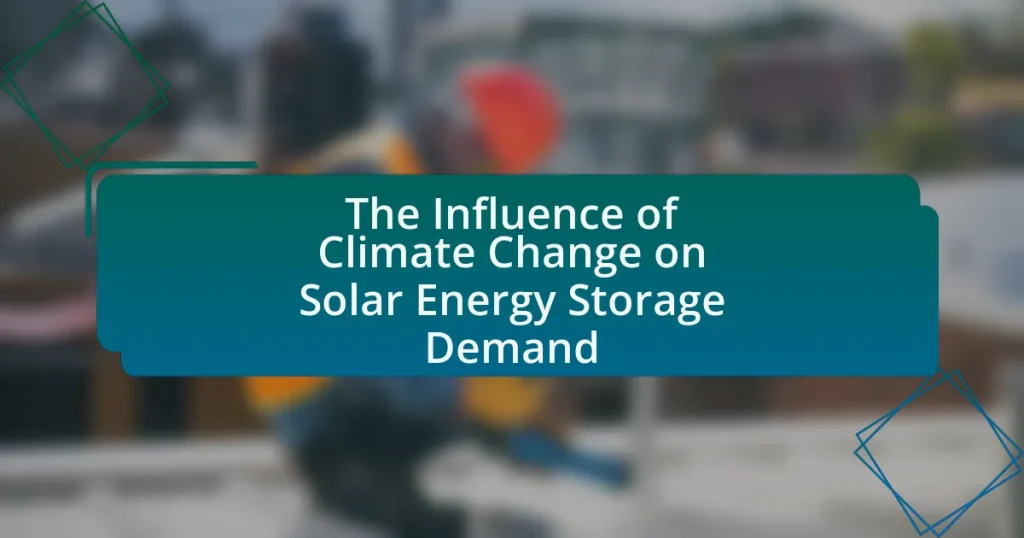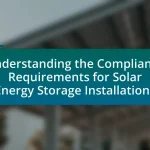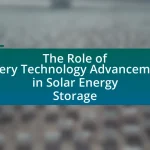The article examines the influence of climate change on the demand for solar energy storage, highlighting the critical need for reliable energy sources amid increasing extreme weather events and shifting consumption patterns. It discusses how rising temperatures and extreme weather disrupt energy production and storage efficiency, necessitating advancements in solar energy storage technologies. Key factors driving this demand include the need for energy reliability, government policies, and technological innovations, while also addressing the economic implications and best practices for optimizing solar energy storage systems in a changing climate. The article emphasizes the importance of solar energy in reducing carbon emissions and enhancing energy resilience, ultimately contributing to a sustainable energy future.
What is the Influence of Climate Change on Solar Energy Storage Demand?
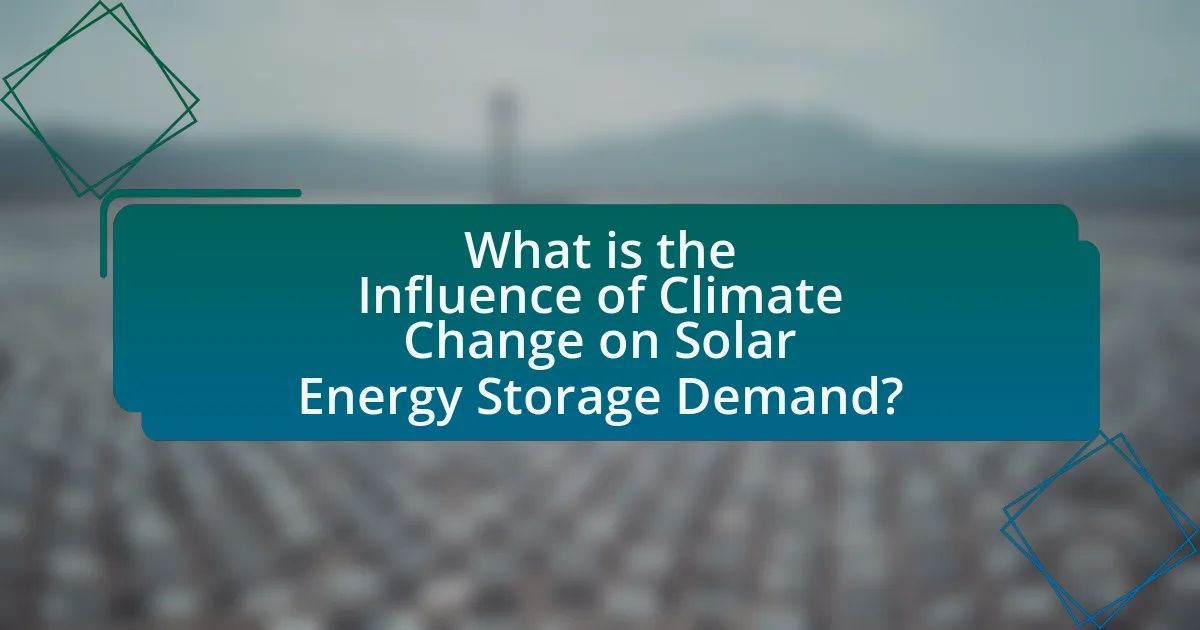

Climate change significantly increases the demand for solar energy storage due to the need for reliable energy sources amid extreme weather events and shifting energy consumption patterns. As climate change leads to more frequent and severe weather phenomena, such as storms and heatwaves, the stability of energy supply becomes critical. This instability drives the necessity for energy storage solutions that can store excess solar energy generated during peak sunlight hours for use during periods of low generation or high demand. Furthermore, according to the International Energy Agency, the global energy storage market is projected to grow substantially, with solar energy storage playing a pivotal role in achieving energy resilience and sustainability in the face of climate challenges.
How does climate change impact energy consumption patterns?
Climate change significantly alters energy consumption patterns by increasing demand for cooling and heating due to extreme weather events. For instance, rising temperatures lead to higher electricity usage for air conditioning, while colder winters may increase heating requirements. According to the U.S. Energy Information Administration, electricity consumption for residential cooling is projected to rise by 20% by 2050 due to climate change. Additionally, climate change can disrupt energy supply chains, leading to fluctuations in energy availability and prices, which further influences consumption behavior.
What are the specific effects of rising temperatures on energy storage needs?
Rising temperatures increase energy storage needs by exacerbating the demand for cooling and reducing the efficiency of energy systems. As temperatures rise, electricity consumption for air conditioning and cooling systems escalates, leading to higher peak demand periods. Additionally, elevated temperatures can diminish the performance of batteries and other storage technologies, resulting in a need for larger or more efficient storage solutions to meet the increased energy demand. For instance, studies indicate that lithium-ion battery performance can degrade at higher temperatures, necessitating more robust thermal management systems and potentially increasing the overall capacity required for energy storage.
How do extreme weather events influence solar energy production and storage?
Extreme weather events significantly disrupt solar energy production and storage by reducing efficiency and damaging infrastructure. For instance, heavy rainfall and flooding can obscure solar panels, leading to decreased energy generation, while high winds and storms can physically damage solar installations. According to a study by the National Renewable Energy Laboratory, extreme weather can reduce solar output by up to 30% during adverse conditions. Additionally, temperature extremes can affect battery storage systems, as high temperatures can lead to overheating and reduced lifespan of batteries, while cold temperatures can decrease their efficiency. This interplay between extreme weather and solar energy systems highlights the vulnerability of solar infrastructure to climate-related impacts.
Why is solar energy storage becoming increasingly important?
Solar energy storage is becoming increasingly important due to the growing need for reliable energy supply and the integration of renewable energy sources into the grid. As solar energy generation is intermittent, energy storage systems enable the capture and retention of excess energy produced during peak sunlight hours for use during periods of low generation, such as at night or on cloudy days. This capability enhances grid stability and reduces reliance on fossil fuels, which is crucial in the context of climate change. According to the International Energy Agency, energy storage capacity is projected to grow significantly, reaching 1,200 gigawatts by 2040, highlighting its essential role in transitioning to a sustainable energy future.
What role does solar energy play in reducing carbon emissions?
Solar energy plays a crucial role in reducing carbon emissions by providing a clean, renewable source of electricity that displaces fossil fuel use. When solar panels convert sunlight into electricity, they generate power without emitting carbon dioxide or other greenhouse gases, which are significant contributors to climate change. According to the International Energy Agency, solar energy has the potential to reduce global carbon emissions by up to 4.5 gigatons annually by 2040, significantly mitigating the impact of climate change. This transition to solar energy not only decreases reliance on carbon-intensive energy sources but also promotes sustainable energy practices, further contributing to a reduction in overall emissions.
How does energy storage enhance the reliability of solar power?
Energy storage enhances the reliability of solar power by allowing excess energy generated during peak sunlight hours to be stored and used during periods of low sunlight or high demand. This capability ensures a consistent power supply, mitigating the intermittent nature of solar energy. For instance, battery storage systems can store solar energy generated during the day and release it at night or during cloudy weather, thus providing a stable energy output. According to the U.S. Department of Energy, integrating energy storage with solar power can increase grid reliability and resilience, particularly in regions experiencing extreme weather events linked to climate change.
What are the key factors driving the demand for solar energy storage?
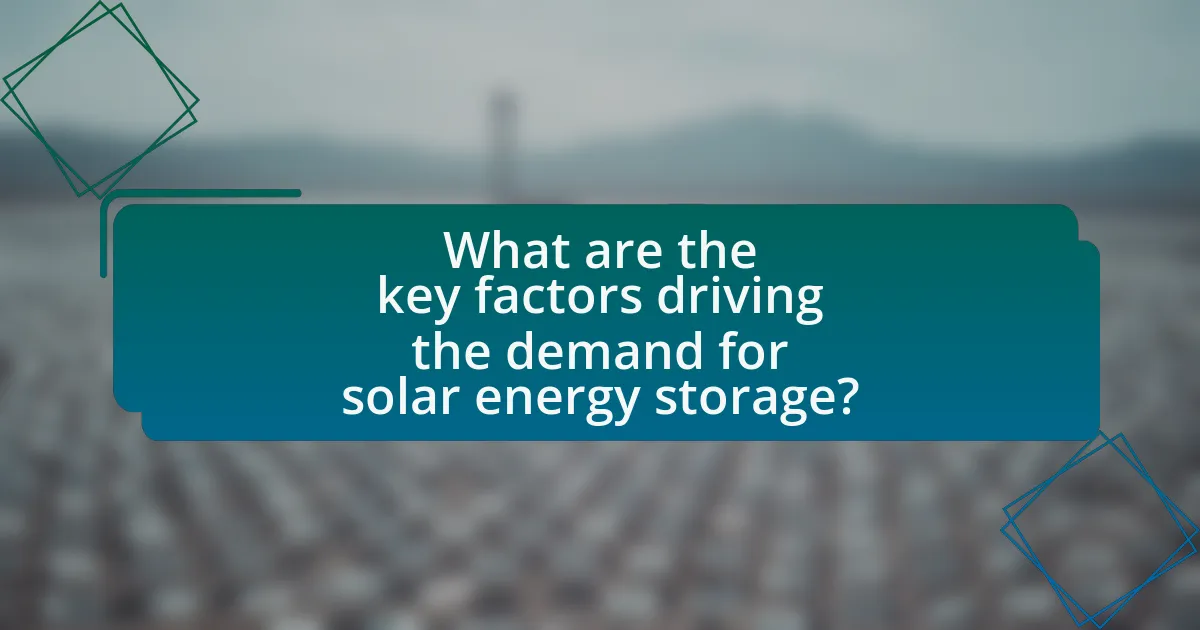

The key factors driving the demand for solar energy storage include the increasing need for energy reliability, the rise in renewable energy adoption, and the growing emphasis on reducing carbon emissions. Energy reliability is crucial as consumers and businesses seek to mitigate the impact of power outages and fluctuations in energy supply. The adoption of renewable energy sources, particularly solar power, has surged, necessitating effective storage solutions to manage the intermittent nature of solar generation. Additionally, global initiatives aimed at reducing carbon footprints and combating climate change are pushing both individuals and organizations to invest in solar energy storage systems, which facilitate the use of clean energy and enhance energy independence. According to the International Energy Agency, the global energy storage market is projected to grow significantly, driven by these factors, with a forecasted increase in installed capacity from 10 gigawatts in 2020 to over 200 gigawatts by 2030.
How do government policies affect solar energy storage demand?
Government policies significantly influence solar energy storage demand by providing financial incentives, regulatory frameworks, and support for research and development. For instance, policies such as tax credits, rebates, and grants encourage consumers and businesses to invest in solar energy storage systems, thereby increasing demand. According to the Solar Energy Industries Association, the federal Investment Tax Credit (ITC) has been pivotal in boosting solar installations, which directly correlates with the need for storage solutions to manage energy supply and demand effectively. Additionally, regulations that mandate renewable energy usage or set energy storage targets further drive the market, as seen in states like California, which has implemented policies requiring utilities to procure energy storage capacity. These measures create a favorable environment for solar energy storage adoption, demonstrating the critical role of government policies in shaping market dynamics.
What incentives are available for solar energy storage systems?
Incentives for solar energy storage systems include federal tax credits, state rebates, and performance-based incentives. The federal Investment Tax Credit (ITC) allows homeowners and businesses to deduct a significant percentage of the cost of solar energy systems, including storage, from their federal taxes. Additionally, many states offer rebates that can reduce the upfront costs of purchasing and installing solar storage systems. Performance-based incentives, which pay users based on the amount of energy stored or generated, are also available in various regions. These incentives are designed to promote the adoption of renewable energy technologies and can significantly lower the overall cost of solar energy storage systems.
How do regulations impact the adoption of solar energy storage technologies?
Regulations significantly influence the adoption of solar energy storage technologies by establishing standards, incentives, and barriers that affect market dynamics. For instance, government policies such as tax credits, rebates, and renewable energy mandates encourage investment in solar storage systems, making them more financially viable for consumers and businesses. According to the U.S. Energy Information Administration, states with supportive regulations, like California, have seen a substantial increase in solar storage installations, with a reported growth of over 200% in recent years. Conversely, stringent regulations or lack of supportive policies can hinder adoption by increasing costs or complicating the installation process, as seen in regions with less favorable regulatory environments.
What technological advancements are influencing solar energy storage?
Technological advancements influencing solar energy storage include improvements in battery technology, such as lithium-ion and solid-state batteries, which enhance energy density and lifespan. Lithium-ion batteries have seen a significant reduction in cost, dropping by approximately 89% from 2010 to 2020, making them more accessible for solar energy applications. Solid-state batteries, which utilize a solid electrolyte instead of a liquid one, promise increased safety and efficiency, potentially doubling energy density compared to traditional lithium-ion batteries. Additionally, advancements in energy management systems and artificial intelligence optimize the charging and discharging processes, improving overall system efficiency and reliability. These innovations collectively address the growing demand for efficient solar energy storage solutions driven by climate change.
What are the latest innovations in battery technology for solar energy storage?
The latest innovations in battery technology for solar energy storage include solid-state batteries, lithium-sulfur batteries, and advancements in flow battery systems. Solid-state batteries utilize a solid electrolyte instead of a liquid one, enhancing safety and energy density, which can lead to longer-lasting storage solutions. Lithium-sulfur batteries offer a higher theoretical energy density compared to traditional lithium-ion batteries, potentially reducing costs and weight for solar energy applications. Flow batteries, particularly vanadium redox flow batteries, provide scalable energy storage solutions with long cycle life and the ability to decouple power and energy capacity, making them suitable for large-scale solar installations. These innovations are crucial in addressing the increasing demand for efficient and reliable solar energy storage driven by climate change.
How do improvements in energy management systems enhance storage efficiency?
Improvements in energy management systems enhance storage efficiency by optimizing the use and allocation of energy resources. These systems utilize advanced algorithms and real-time data analytics to monitor energy consumption patterns, predict demand, and manage energy storage systems more effectively. For instance, a study by the International Energy Agency highlights that implementing smart energy management systems can increase storage utilization rates by up to 30%, thereby reducing energy waste and improving overall efficiency.
What challenges does the solar energy storage market face due to climate change?
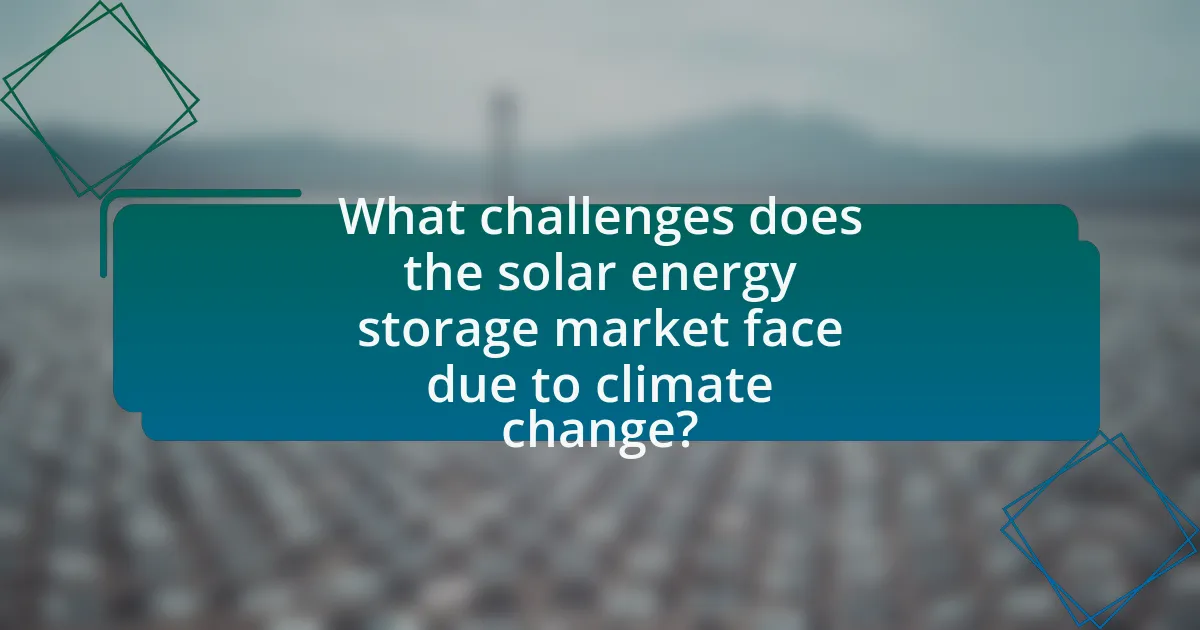

The solar energy storage market faces significant challenges due to climate change, primarily including increased frequency of extreme weather events and the impact on energy demand patterns. Extreme weather, such as hurricanes and floods, can damage solar infrastructure and disrupt supply chains, leading to higher costs and reduced availability of storage systems. Additionally, climate change alters energy consumption patterns, often increasing demand during peak periods when renewable generation may be less reliable, thereby straining storage capabilities. According to a report by the International Renewable Energy Agency, the need for resilient energy systems is critical as climate-related disruptions are projected to rise, emphasizing the urgency for advancements in energy storage technologies to adapt to these changing conditions.
How does climate variability affect the reliability of solar energy storage systems?
Climate variability significantly impacts the reliability of solar energy storage systems by affecting the consistency of solar energy generation. Variations in weather patterns, such as increased cloud cover, precipitation, and temperature fluctuations, can lead to reduced solar irradiance, which directly decreases the amount of energy captured by solar panels. For instance, studies have shown that regions experiencing more frequent extreme weather events, such as storms or prolonged droughts, can see a drop in solar energy production by up to 30% during peak seasons. This inconsistency in energy generation challenges the effectiveness of storage systems, as they rely on predictable input to charge and discharge efficiently. Consequently, the reliability of these systems diminishes, necessitating advancements in technology and infrastructure to adapt to changing climate conditions.
What are the risks associated with energy storage during extreme weather conditions?
Energy storage systems face several risks during extreme weather conditions, including physical damage, reduced efficiency, and safety hazards. For instance, high temperatures can lead to overheating of batteries, which may result in thermal runaway, a condition that can cause fires or explosions. Additionally, heavy rainfall or flooding can compromise the integrity of storage facilities, leading to short circuits or equipment failure. According to the National Renewable Energy Laboratory, extreme weather events can reduce the operational efficiency of energy storage systems by up to 30%, impacting their reliability and performance. Furthermore, ice accumulation on storage units can obstruct access and maintenance, exacerbating operational challenges. These risks highlight the need for robust design and management strategies to mitigate the impacts of climate change on energy storage systems.
How can the industry mitigate the impacts of climate change on storage systems?
The industry can mitigate the impacts of climate change on storage systems by implementing advanced materials and technologies that enhance efficiency and resilience. For instance, utilizing solid-state batteries instead of traditional lithium-ion batteries can significantly improve thermal stability and reduce the risk of degradation due to temperature fluctuations. Research indicates that solid-state batteries can operate effectively in a wider range of temperatures, thus addressing the challenges posed by climate change. Additionally, integrating renewable energy sources with smart grid technology can optimize energy storage and distribution, ensuring that storage systems are more adaptable to changing environmental conditions.
What economic factors influence the solar energy storage market?
The solar energy storage market is influenced by several economic factors, including government incentives, the cost of technology, and market demand for renewable energy. Government incentives, such as tax credits and subsidies, significantly lower the initial investment for solar energy systems, making them more attractive to consumers. The cost of technology, particularly battery storage solutions, has decreased by over 80% since 2010, enhancing affordability and adoption rates. Additionally, increasing market demand for renewable energy, driven by climate change awareness and energy independence goals, further propels investment in solar energy storage solutions. These factors collectively shape the economic landscape of the solar energy storage market.
How do fluctuating energy prices affect the demand for solar energy storage?
Fluctuating energy prices significantly increase the demand for solar energy storage. When energy prices rise, consumers and businesses seek ways to reduce their reliance on the grid, leading to greater interest in solar energy systems paired with storage solutions. For instance, a study by the National Renewable Energy Laboratory found that as retail electricity prices increase, the economic viability of solar-plus-storage systems improves, making them more attractive to potential users. This trend is further supported by the fact that in regions with high energy price volatility, the return on investment for solar energy storage becomes more favorable, driving adoption rates higher.
What is the cost-benefit analysis of investing in solar energy storage solutions?
Investing in solar energy storage solutions typically yields significant long-term financial benefits that outweigh initial costs. The initial investment for solar energy storage systems, such as lithium-ion batteries, can range from $5,000 to $15,000, depending on capacity and installation. However, these systems can reduce electricity bills by storing energy during low-cost periods and using it during peak demand times, leading to savings of 30% or more on energy costs annually.
Additionally, solar energy storage enhances energy independence and resilience, particularly during power outages or extreme weather events exacerbated by climate change. According to the U.S. Department of Energy, homes with solar storage can maintain power during grid failures, providing critical support in emergencies.
Furthermore, government incentives, such as the Federal Investment Tax Credit, can offset installation costs by up to 26%, making the investment more attractive. The growing demand for renewable energy solutions, driven by climate change concerns, is expected to increase the value of solar energy storage systems, as they contribute to a more sustainable energy grid.
In summary, the cost-benefit analysis of investing in solar energy storage solutions shows that while initial costs are significant, the long-term savings, energy independence, and potential for increased property value provide compelling reasons for investment.
What are the best practices for optimizing solar energy storage in a changing climate?
The best practices for optimizing solar energy storage in a changing climate include implementing advanced battery technologies, enhancing system efficiency, and utilizing predictive analytics for energy management. Advanced battery technologies, such as lithium-ion and solid-state batteries, offer higher energy density and longer life cycles, which are crucial for adapting to fluctuating energy demands due to climate variability. Enhancing system efficiency through improved inverter technology and energy management systems can maximize energy capture and storage, ensuring that solar energy is effectively utilized even during periods of low sunlight. Additionally, predictive analytics can forecast energy production and consumption patterns, allowing for better planning and integration of solar energy into the grid. These practices are supported by studies indicating that optimizing storage solutions can significantly improve the resilience and reliability of solar energy systems in the face of climate change.
How can users effectively manage their solar energy storage systems?
Users can effectively manage their solar energy storage systems by implementing smart energy management strategies that optimize usage and storage. This includes monitoring energy consumption patterns, utilizing energy management systems (EMS) to automate charging and discharging cycles, and scheduling energy use during peak solar production times. Research indicates that users who actively engage in these practices can increase their system efficiency by up to 30%, as reported by the National Renewable Energy Laboratory. Additionally, regular maintenance and software updates for storage systems ensure optimal performance and longevity, further enhancing energy management.
What strategies can be implemented to enhance the resilience of solar energy storage systems?
To enhance the resilience of solar energy storage systems, implementing strategies such as improving battery technology, integrating advanced energy management systems, and diversifying energy sources is essential. Improving battery technology, particularly through the development of solid-state batteries, can increase energy density and lifespan, thereby reducing the frequency of replacements and enhancing reliability. Advanced energy management systems can optimize energy usage and storage, allowing for better response to fluctuations in energy supply and demand. Additionally, diversifying energy sources, such as incorporating hybrid systems that combine solar with wind or hydro, can provide backup during periods of low solar generation, thus ensuring a more stable energy supply. These strategies collectively address the challenges posed by climate change, such as extreme weather events, which can disrupt energy systems.
